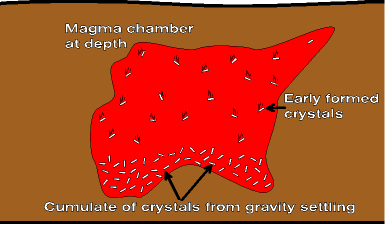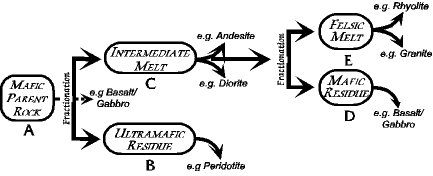|
Crystallization, and Melting:
Alternative Fractionation Processes
Fractional Crystallization
Fractionation is the splitting of an original magma or rock into two fractions, each of different composition than the original. One fraction becomes more mafic rich on Bowen's Reaction Series, the other more felsic.
Bowen's original idea was that fractionation occurred during the crystallization process. The process begins with a magma (melt) slowly cooling. Crystallization begins with minerals highest in the reaction series. Because these minerals have the highest specific gravity they settle to the bottom of the magma chamber by gravity settling.  Also, because these first formed minerals are high in Ca, Mg, and Fe, they take these elements to the bottom with them in greater quantities than their average composition in the original melt. The remaining melt is thus depleted in Ca, Mg, and Fe, and has a composition lower in the reaction series. Also, because these first formed minerals are high in Ca, Mg, and Fe, they take these elements to the bottom with them in greater quantities than their average composition in the original melt. The remaining melt is thus depleted in Ca, Mg, and Fe, and has a composition lower in the reaction series.
Thus, the original magma of one composition is divided into two fractions. The first fraction is a cumulate (early formed crystals which " accumulate" at the bottom of the magma chamber) collected at the bottom of the magma chamber composed of high density Ca, Mg, and Fe rich minerals from the top of BRS. The second fraction is the lower density, more Na, K, and Si rich remaining melt with a composition lower down in BRS.
There are practical problems with fractional crystallization. For one, gravity settling is a slow process, and requires more time than is normally available. And two, for gravity settling to occur the cooling magma must remain still, a difficult state for a hot, turbulent melt. Nonetheless, field evidence indicates that gravity settling does occur, at least under some conditions, but it not as significant a mechanism for igneous rock evolution as fractional melting.
Fractional Melting
With the development of plate tectonic theory, and the discovery of convergent and divergent boundaries, new processes of fractionation became possible - specifically, fractional melting. The mechanisms of fractional melting occurs at both divergent and convergent boundaries.
At divergent boundaries convection cells bring hot, plastic, silica-rich ultramafic rock toward the surface. The fractionation and solidification of these magmas form the ophiolite suite, the four layers of rock that form the oceanic lithosphere. At depth the plastic, slow moving rock is under great pressure and so has a high melting point. At it moves closer to the surface the pressure diminishes and the hot rock begins to fractionally melt. A basalt " sweats" off and rises to form the pillow basalts of the ocean floor. The unmelted residue is olivine (dunite) and pyroxene rich (peridotite) ultramafics which remain in the mantle.
Factional melting at convergent boundaries occurs above the subducting oceanic plate. Cold basalt of the ocean floor descends into the mantle and gradually heats because of the geothermal gradient and friction of subduction. But the descending slab also carries a lot of sea water with it and at about 120 km down the water and heat lead to fractional melting. The hot melt rises toward the surface, emplacing and crystallizing to form intermediate (diorite, granodiorite, etc.) plutons. The unmelted mafic/ultramafic residue is left behind.
Sorting through the mechanisms by which igneous rock fractionation and evolution takes place is a lot of heavy duty chemistry and mathematics (thermodynamics). But we can understand it descriptively as done here, or at a slightly deeper level through the study of phase diagrams, or a a more abstract level through the theory of dissipative structures, and the evolution of complex systems.
 Go to page on Phase Diagrams Go to page on Phase Diagrams
 Go to page on Solid Solution Phase Diagram Go to page on Solid Solution Phase Diagram
 Go to page on Binary Eutectic Phase Diagram Go to page on Binary Eutectic Phase Diagram
 Go to page continuing Igneous Rock Evolution Go to page continuing Igneous Rock Evolution
 Go to Igneous Rock Home Page Go to Igneous Rock Home Page
|


 Also, because these first formed minerals are high in Ca, Mg, and Fe, they take these elements to the bottom with them in greater quantities than their average composition in the original melt. The remaining melt is thus depleted in Ca, Mg, and Fe, and has a composition lower in the reaction series.
Also, because these first formed minerals are high in Ca, Mg, and Fe, they take these elements to the bottom with them in greater quantities than their average composition in the original melt. The remaining melt is thus depleted in Ca, Mg, and Fe, and has a composition lower in the reaction series.